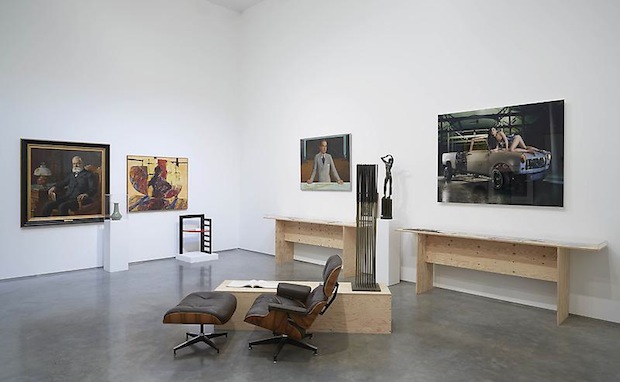Another Look at Detroit
Marlborough Chelsea
545 West 25th Street
New York, NY 10011
Marianne Boesky Gallery
509 West 24th Street
New York, NY 10011
Runs through August 8, 2014
What’s on view: A two-part show at Marlborough Chelsea and Marianne Boesky Gallery. Art advisor Todd Levin brings together 67 artists in an eclectic encyclopedic-palace-style arrangement. The show at Marianne Boesky seems to be organized around Detroit as an industrial boomtown, with things like late-50s ads for Fords; industrialists’ portraits (one by Diego Rivera); Liz Cohen’s slutty pin-up girls; and sexy, whirring abstraction by Julie Mehretu. The second looks at the pre- and post-crash era, with Destroy All Monsters and noise music; junk assemblage by Nick Cave; charred plastic dolls by Scott Hocking; black-and-white photos of post-60s Detroit streets; and starker, less colorful abstraction.
Whitney: This is about as sexy as Chelsea group shows get; electric connections and weird, psychedelic moments that reminded me of Massimiliano Gioni and Trisha Donnelly’s curatorial sensibility. Lots of hand-picked gems that made me want to buy a catalogue.
Levin has conceived of an especially bright device in the entryways, which immediately signals a change between the two shows. The set-up is identical; walk through black curtains to find hanging light bulbs which illuminate opposite corners on the rooms. At Boesky: antique lightbulbs, classical prints of a flourishing city, and a vitrine containing James Lee Byars’s pristine “The One-Page Book” (1972) containing a single microscopic sentence. At Marlborough: harsh, uncased fluorescent bulbs illuminate Kate Levant’s 2014 charcoal drawing of a man under a bridge with the line “What the hell is going on?” next to Bill Rauhauser’s 1960s photo of an almost all-African-American working-class crowd walking down the street. This time the vitrine contains a charred copy of “New Book of Knowledge” (2010) by Scott Hocking. With the exception of Bill Rauhauser’s photo (which could really be any city) the stark difference drives home the point that something has been fucked.
And there are tons of great works inside both parts: Liz Cohen’s video “Hydroforce” (2011) shows a sexy, sleazy girl riding the front seat of an old car as it’s raised up and down; it’s a perfect metaphor for aging car-lust. There’s an Eames lounge chair; a giant “Destroy All Monsters” banner which I want; and lots of beautiful old landscape paintings.

Max Ortiz’s “Johnnie Redding Frozen in Elevator Shaft,” 2009. (Image courtesy of The Detroit News via AP)
I’m not sure the ends justify the means, though, which is to take everything out of context and arrange objects by motifs. You can’t shake the feeling of art tourism when you’re looking at, say, Mortimer Smith’s beautiful elk filled Hudson River-style painting “Winter Landscape”next to Max Ortiz’s “Johnnie Redding Frozen in Elevator Shaft,” a photo of legs sticking out of ice in an elevator shaft. That image ran in the Detroit News with an actual story about a man who died of a coke overdose and then froze without a burial. Taking the image on aesthetic alone for maximum emotional effect seems kind of irresponsible. And what do sexy abstract works by Scott Reeder or Dana Schutz—both of whose work appears regularly on the New York scene—really have to do with post-crash Detroit? There are lots of Detroit natives here (Schutz is from a nearby suburb, and Reeder lives there), but many of them are also fixtures in the international art scene. As Paddy pointed out in the office, there are ghettos all over New York but the art world only ever goes out there for photo ops. This feels more like schadenfreude bandwagoning than an eye-to-eye look.
Corinna: Yup. It’s hard to imagine what eye-to-eye would even look like in this show. I found it difficult to engage with individual works because my eyes kept zooming left and right, up and down, trying to figure out connections between objects you’ll rarely see together. Try to imagine all the possible links between a high-end Anna Sui suit floating on a hanger, seen in the same room as Mike E. Smith’s taxidermic pigeon attached to a basket, and you might be there for a while. But it wasn’t an entirely disconnected show. Like you’d mentioned with the Gioni comparison, there’s definitely room for some magic to happen while you’re ambling about in this curated forest.
Some themes did emerge—Detroit’s dual-obsession with landscape and industry over the centuries—and then, the minor rebellions that emerged since the 1960s in an attempt to overcome that history—the rock, punk, and techno scenes (MC5, Destroy All Monsters, Metroplex records), the emphasis on discarded or cheap materials (Nick Cave, Kate Levant, Mike E. Smith). I could’ve done without some of the tried-and-true names like Dana Schutz and Scott Reeder. It’s nothing personal about the work (although I’ve seen much stronger Schutzes); the exhibition could’ve been sharper if it really focused on artists with a stronger connection to the city or a particular style from the city, not some airy network of artists inspired by Detroit.
One important point to note: there’s not much in the way of Detroit ruin porn here. Except for the show’s final work, which you already mentioned, Max Ortiz’s “Johnnie Redding Frozen in Elevator Shaft.” In it, we see Johnnie, a sometimes-homeless drug addict who’d been found dead in one of Detroit’s many abandoned warehouses.
Jesus. Couldn’t we choose a more uplifting point to end on? Or anything else at all?
Whitney: Well, I don’t think we need “uplifting” in a show about a city that’s in pretty dire straits, but this might look different if it had dug a little deeper for community that’s very much alive in that city.



Comments on this entry are closed.